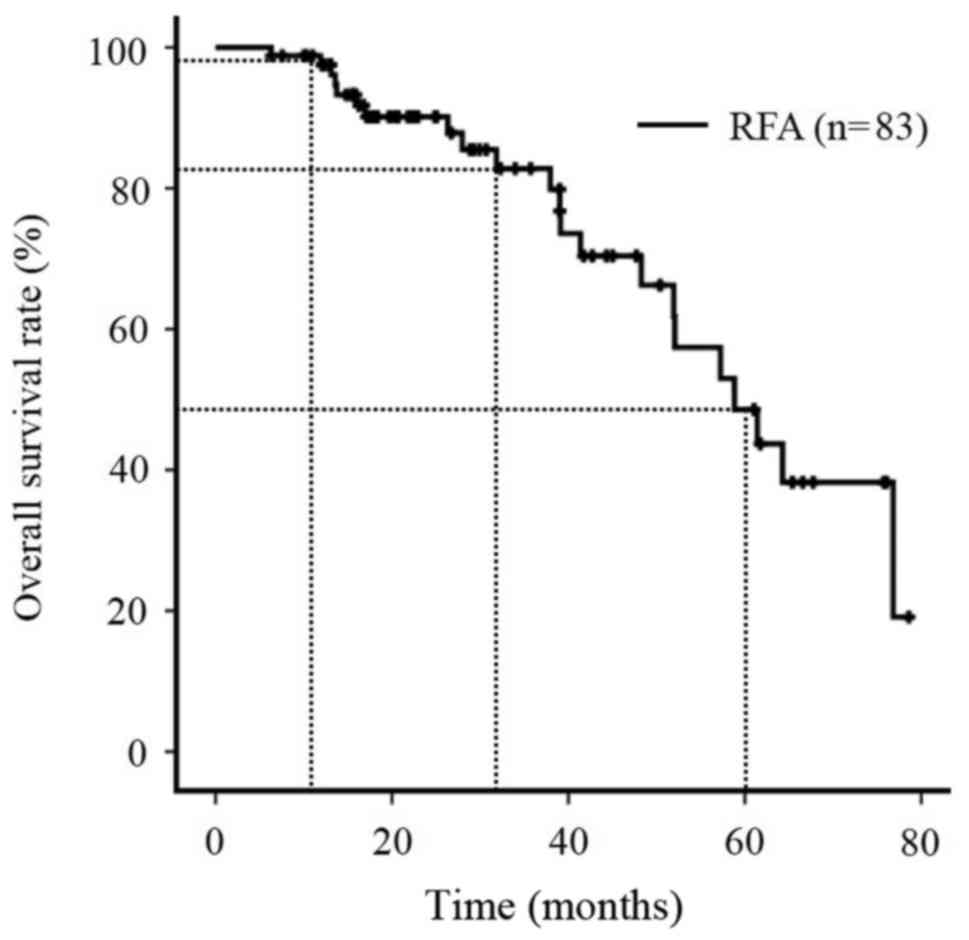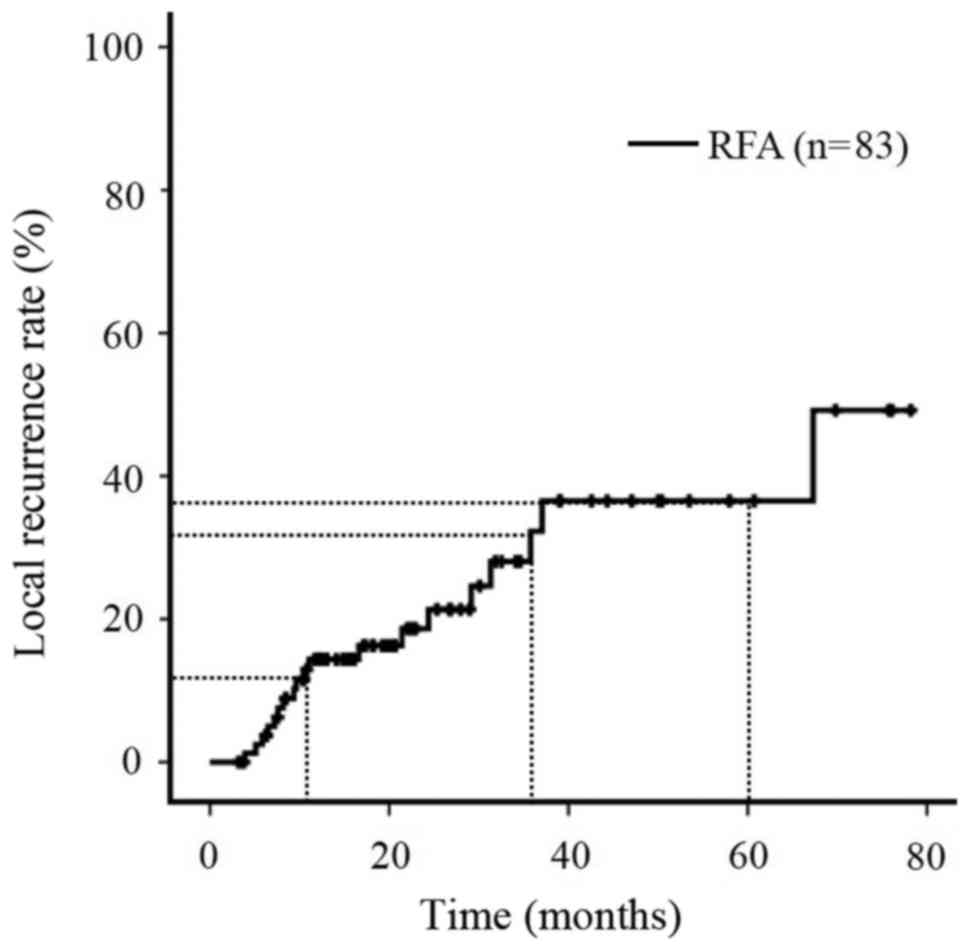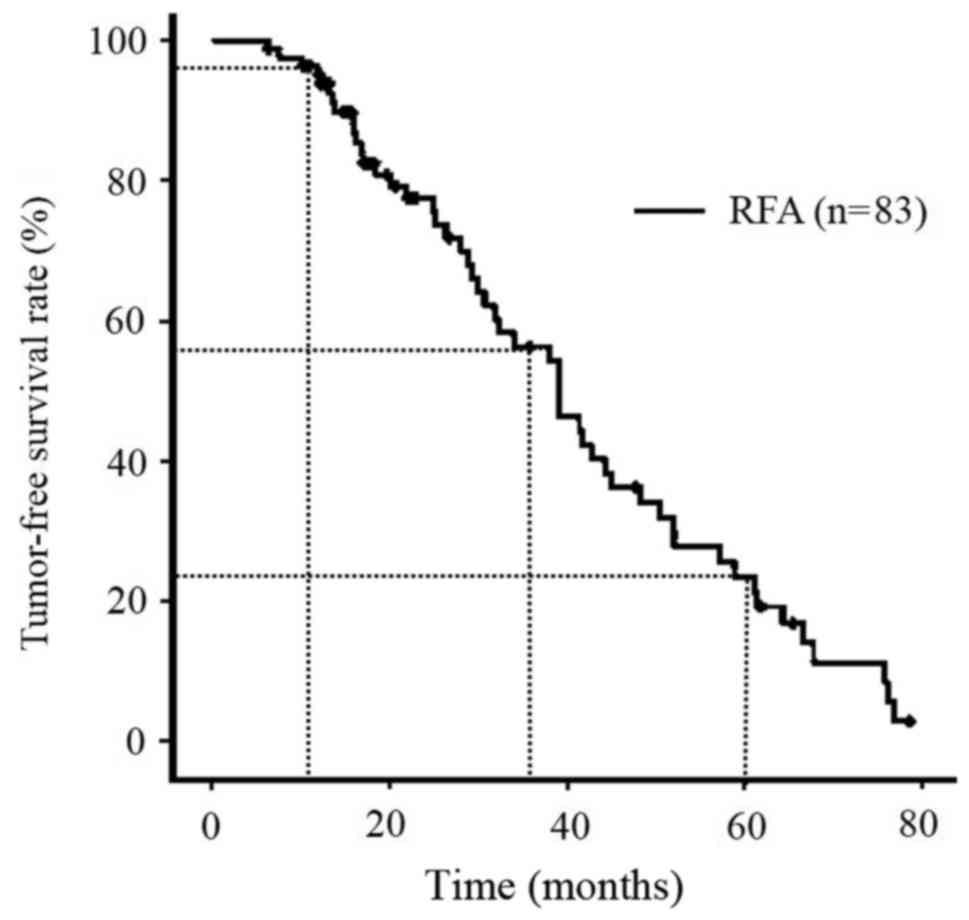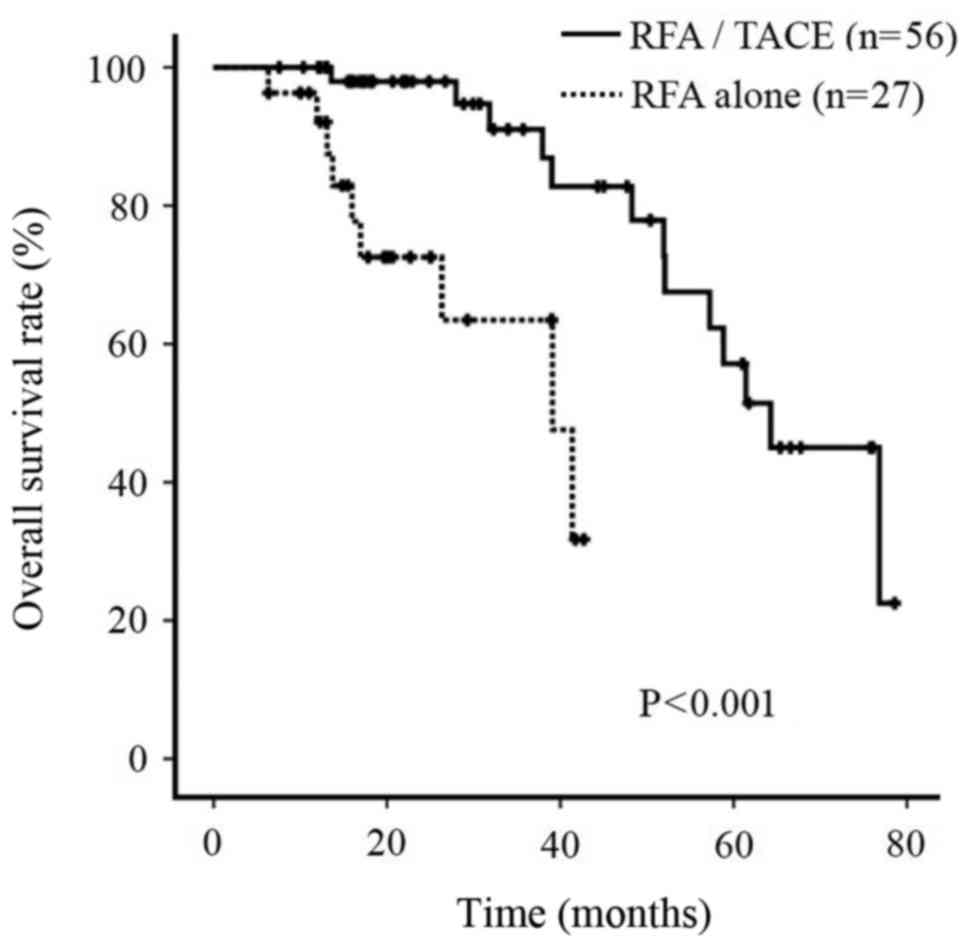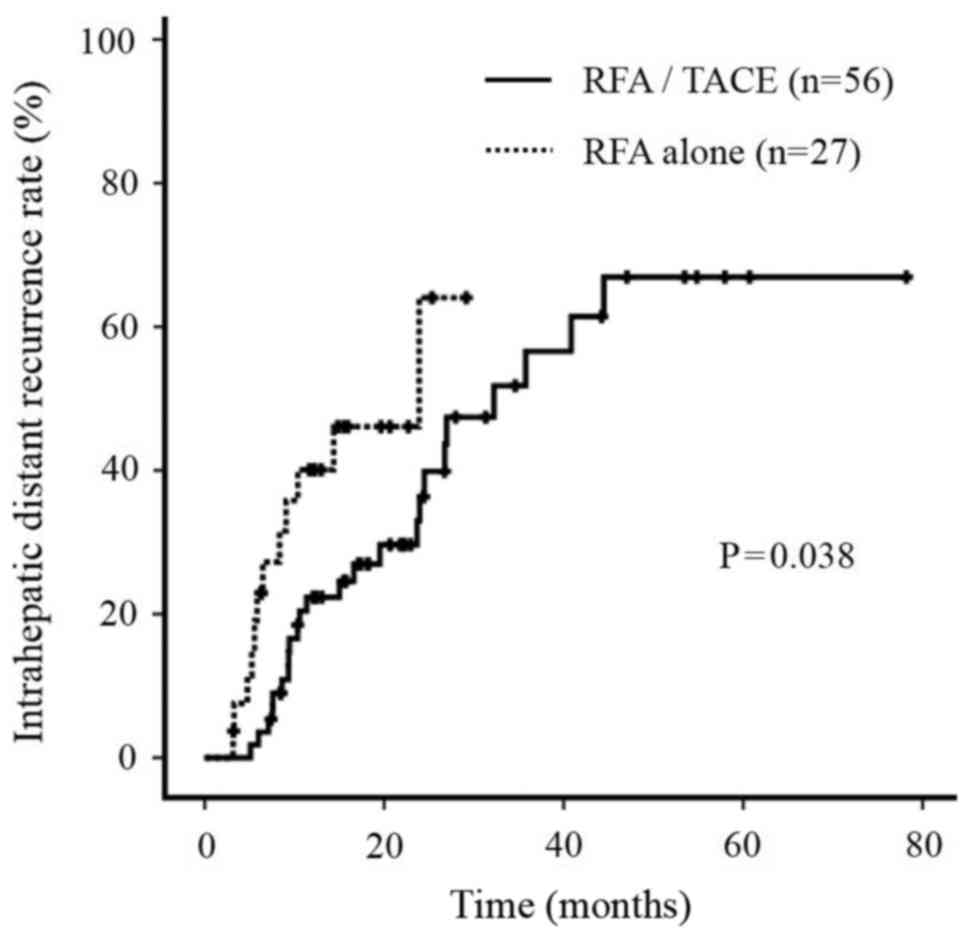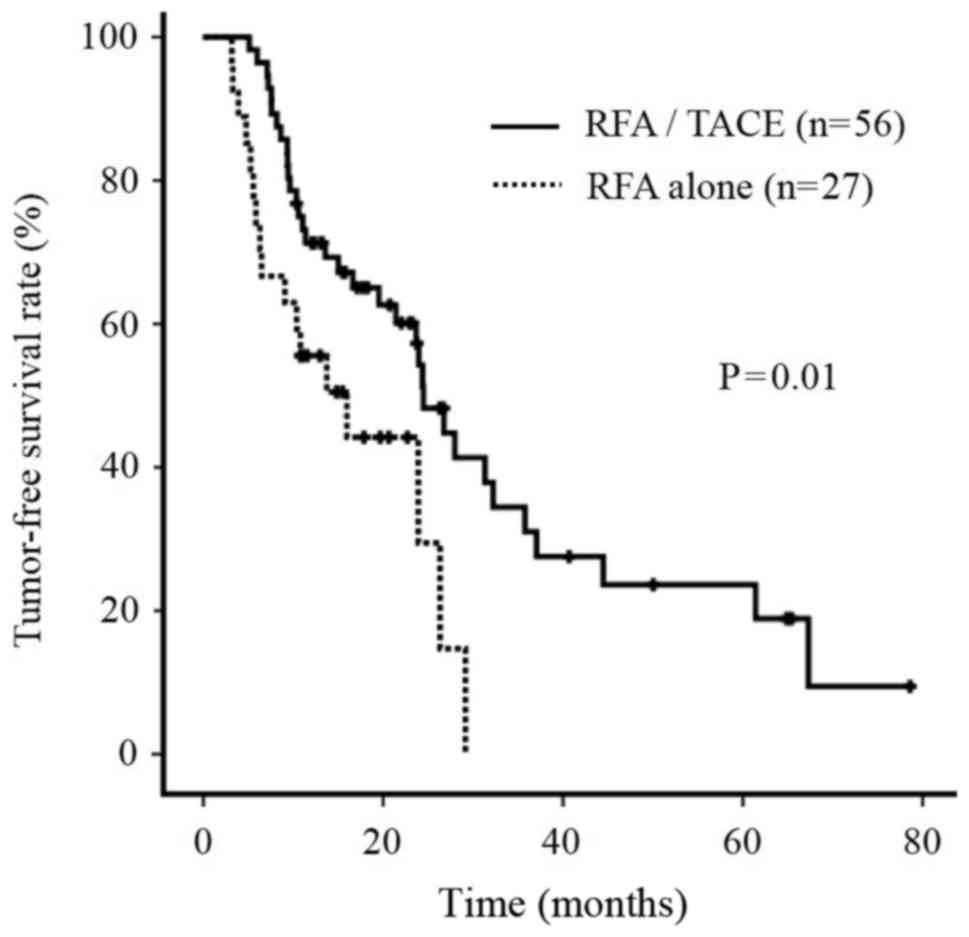|
1
|
Torre LA, Bray F, Siegel RL, Ferlay J,
Lortet-Tieulent J and Jemal A: Global cancer statistics, 2012. CA
Cancer J Clin. 65:87–108. 2015. View Article : Google Scholar : PubMed/NCBI
|
|
2
|
Bruix J and Sherman M; American
Association for the Study of Liver Diseases, : Management of
hepatocellular carcinoma: An update. Hepatology. 53:1020–1022.
2011. View Article : Google Scholar : PubMed/NCBI
|
|
3
|
European Association For The Study Of The
Liver; European Organisation For Research And Treatment Of Cancer:
EASL-EORTC clinical practice guidelines: Management of
hepatocellular carcinoma. J Hepatol. 56:908–943. 2012. View Article : Google Scholar : PubMed/NCBI
|
|
4
|
Kudo M, Matsui O, Izumi N, Iijima H,
Kadoya M, Imai Y, Okusaka T, Miyayama S, Tsuchiya K, Ueshima K, et
al: JSH consensus-based clinical practice guidelines for the
management of hepatocellular carcinoma: 2014 Update by the Liver
Cancer Study Group of Japan. Liver Cancer. 3:458–468. 2014.
View Article : Google Scholar : PubMed/NCBI
|
|
5
|
Lafaro KJ, Demirjian AN and Pawlik TM:
Epidemiology of hepatocellular carcinoma. Surg Oncol Clin N Am.
24:1–17. 2015. View Article : Google Scholar : PubMed/NCBI
|
|
6
|
Takayama T, Makuuchi M, Hirohashi S,
Sakamoto M, Yamamoto J, Shimada K, Kosuge T, Okada S, Takayasu K
and Yamasaki S: Early hepatocellular carcinoma as an entity with a
high rate of surgical cure. Hepatology. 28:1241–1246. 1998.
View Article : Google Scholar : PubMed/NCBI
|
|
7
|
Hong SN, Lee SY, Choi MS, Lee JH, Koh KC,
Paik SW, Yoo BC, Rhee JC, Choi D, Lim HK, et al: Comparing the
outcomes of radiofrequency ablation and surgery in patients with a
single small hepatocellular carcinoma and well-preserved hepatic
function. J Clin Gastroenterol. 39:247–252. 2005. View Article : Google Scholar : PubMed/NCBI
|
|
8
|
Ueno M, Hayami S, Shigekawa Y, Kawai M,
Hirono S, Okada K, Tamai H, Shingaki N, Mori Y, Ichinose M and
Yamaue H: Prognostic impact of surgery and radiofrequency ablation
on single nodular HCC 5 cm: Cohort study based on serum HCC
markers. J Hepatol. 63:1352–1359. 2015. View Article : Google Scholar : PubMed/NCBI
|
|
9
|
Nakai M, Sato M, Sahara S, Takasaka I,
Kawai N, Minamiguchi H, Tanihata H, Kimura M and Takeuchi N:
Radiofrequency ablation assisted by real-time virtual sonography
and CT for hepatocellular carcinoma undetectable by conventional
sonography. Cardiovasc Intervent Radiol. 32:62–69. 2009. View Article : Google Scholar : PubMed/NCBI
|
|
10
|
Kim JW, Kim JH, Won HJ, Shin YM, Yoon HK,
Sung KB and Kim PN: Hepatocellular carcinomas 2–3 cm in diameter:
Transarterial chemoembolization plus radiofrequency ablation vs.
Radiofrequency ablation alone. Eur J Radiol. 81:e189–e193. 2012.
View Article : Google Scholar : PubMed/NCBI
|
|
11
|
Llovet JM, Brú C and Bruix J: Prognosis of
hepatocellular carcinoma: The BCLC staging classification. Semin
Liver Dis. 19:329–338. 1999. View Article : Google Scholar : PubMed/NCBI
|
|
12
|
Llovet JM, Di Bisceglie AM, Bruix J,
Kramer BS, Lencioni R, Zhu AX, Sherman M, Schwartz M, Lotze M,
Talwalkar J, et al: Design and endpoints of clinical trials in
hepatocellular carcinoma. J Natl Cancer Inst. 100:698–711. 2008.
View Article : Google Scholar : PubMed/NCBI
|
|
13
|
Seldinger SI: Catheter replacement of the
needle in percutaneous arteriography; a new technique. Acta Radiol.
39:368–376. 1953. View Article : Google Scholar : PubMed/NCBI
|
|
14
|
Albers I, Hartmann H, Bircher J and
Creutzfeldt W: Superiority of the Child-Pugh classification to
quantitative liver function tests for assessing prognosis of liver
cirrhosis. Scand J Gastroenterol. 24:269–276. 1989. View Article : Google Scholar : PubMed/NCBI
|
|
15
|
Novák J and Fabian P: Comments on the TNM
classification of malignant tumours-7th edition. Klin Onkol.
24:149–150. 2011.(In Czech). PubMed/NCBI
|
|
16
|
Llovet JM and Bruix J: Novel advancements
in the management of hepatocellular carcinoma in 2008. J Hepatol.
48 Suppl 1:S20–S37. 2008. View Article : Google Scholar : PubMed/NCBI
|
|
17
|
Roayaie S, Blume IN, Thung SN, Guido M,
Fiel MI, Hiotis S, Labow DM, Llovet JM and Schwartz ME: A system of
classifying microvascular invasion to predict outcome after
resection in patients with hepatocellular carcinoma.
Gastroenterology. 137:850–855. 2009. View Article : Google Scholar : PubMed/NCBI
|
|
18
|
Livraghi T, Meloni F, Di Stasi M, Rolle E,
Solbiati L, Tinelli C and Rossi S: Sustained complete response and
complications rates after radiofrequency ablation of very early
hepatocellular carcinoma in cirrhosis: Is resection still the
treatment of choice? Hepatology. 47:82–89. 2008. View Article : Google Scholar : PubMed/NCBI
|
|
19
|
Arii S, Yamaoka Y, Futagawa S, Inoue K,
Kobayashi K, Kojiro M, Makuuchi M, Nakamura Y, Okita K and Yamada
R: Results of surgical and nonsurgical treatment for small-sized
hepatocellular carcinomas: A retrospective and nationwide survey in
Japan. The Liver Cancer Study Group of Japan. Hepatology.
32:1224–1229. 2000. View Article : Google Scholar : PubMed/NCBI
|
|
20
|
Waki K, Aikata H, Katamura Y, Kawaoka T,
Takaki S, Hiramatsu A, Takahashi S, Toyota N, Ito K and Chayama K:
Percutaneous radiofrequency ablation as first-line treatment for
small hepatocellular carcinoma: results and prognostic factors on
long-term follow up. J Gastroenterol Hepatol. 25:597–604. 2010.
View Article : Google Scholar : PubMed/NCBI
|
|
21
|
Nishikawa H, Inuzuka T, Takeda H, Nakajima
J, Sakamoto A, Henmi S, Matsuda F, Eso Y, Ishikawa T, Saito S, et
al: Percutaneous radiofrequency ablation therapy for hepatocellular
carcinoma: A proposed new grading system for the ablative margin
and prediction of local tumor progression and its validation. J
Gastroenterol. 46:1418–1426. 2011. View Article : Google Scholar : PubMed/NCBI
|
|
22
|
Yamakado K, Nakatsuka A, Akeboshi M,
Shiraki K, Nakano T and Takeda K: Combination therapy with
radiofrequency ablation and transcatheter chemoembolization for the
treatment of hepatocellular carcinoma: Short-term recurrences and
survival. Oncol Rep. 11:105–109. 2004.PubMed/NCBI
|
|
23
|
Chen QW, Ying HF, Gao S, Shen YH, Meng ZQ,
Chen H, Chen Z and Teng WJ: Radiofrequency ablation plus
chemoembolization versus radiofrequency ablation alone for
hepatocellular carcinoma: A systematic review and meta-analysis.
Clin Res Hepatol Gastroenterol. 40:309–314. 2016. View Article : Google Scholar : PubMed/NCBI
|
|
24
|
Peng ZW, Zhang YJ, Chen MS, Xu L, Liang
HH, Lin XJ, Guo RP, Zhang YQ and Lau WY: Radiofrequency ablation
with or without transcatheter arterial chemoembolization in the
treatment of hepatocellular carcinoma: A prospective randomized
trial. J Clin Oncol. 31:426–432. 2013. View Article : Google Scholar : PubMed/NCBI
|
|
25
|
Peng ZW, Zhang YJ, Liang HH, Lin XJ, Guo
RP and Chen MS: Recurrent hepatocellular carcinoma treated with
sequential transcatheter arterial chemoembolization and RF ablation
versus RF ablation alone: A prospective randomized trial.
Radiology. 262:689–700. 2012. View Article : Google Scholar : PubMed/NCBI
|
|
26
|
Morimoto M, Numata K, Kondou M, Nozaki A,
Morita S and Tanaka K: Midterm outcomes in patients with
intermediate-sized hepatocellular carcinoma: A randomized
controlled trial for determining the efficacy of radiofrequency
ablation combined with transcatheter arterial chemoembolization.
Cancer. 116:5452–5460. 2010. View Article : Google Scholar : PubMed/NCBI
|
|
27
|
Yang W, Chen MH, Wang MQ, Cui M, Gao W, Wu
W, Wu JY, Dai Y and Yan K: Combination therapy of radiofrequency
ablation and transarterial chemoembolization in recurrent
hepatocellular carcinoma after hepatectomy compared with single
treatment. Hepatol Res. 39:231–240. 2009. View Article : Google Scholar : PubMed/NCBI
|
|
28
|
Shibata T, Isoda H, Hirokawa Y, Arizono S,
Shimada K and Togashi K: Small hepatocellular carcinoma: Is
radiofrequency ablation combined with transcatheter arterial
chemoembolization more effective than radiofrequency ablation alone
for treatment? Radiology. 252:905–913. 2009. View Article : Google Scholar : PubMed/NCBI
|
|
29
|
Shen SQ, Xiang JJ, Xiong CL, Wu SM and Zhu
SS: Intraoperative radiofrequency thermal ablation combined with
portal vein infusion chemotherapy and transarterial
chemoembolization for unresectable HCC. Hepatogastroenterology.
52:1403–1407. 2005.PubMed/NCBI
|
|
30
|
Zhang Z, Wu M, Chen H, Chen D and He J:
Percutaneous radiofrequency ablation combined with transcatheter
arterial chemoembolization for hepatocellular carcinoma. Zhonghua
Wai Ke Za Zhi. 40:826–829. 2002.(In Chinese). PubMed/NCBI
|
|
31
|
Nakashima Y, Nakashima O, Tanaka M, Okuda
K, Nakashima M and Kojiro M: Portal vein invasion and intrahepatic
micrometastasis in small hepatocellular carcinoma by gross type.
Hepatol Res. 26:142–147. 2003. View Article : Google Scholar : PubMed/NCBI
|
|
32
|
Kim TK, Choi BI, Han JK, Chung JW, Park JH
and Han MC: Nontumorous arterioportal shunt mimicking hypervascular
tumor in cirrhotic liver: Two-phase spiral CT findings. Radiology.
208:597–603. 1998. View Article : Google Scholar : PubMed/NCBI
|
|
33
|
Imai Y, Chikayama T, Nakazawa M, Watanabe
K, Ando S, Mizuno Y, Yoshino K, Sugawara K, Hamaoka K, Fujimori K,
et al: Usefulness of miriplatin as an anticancer agent for
transcatheter arterial chemoembolization in patients with
unresectable hepatocellular carcinoma. J Gastroenterol. 47:179–186.
2012. View Article : Google Scholar : PubMed/NCBI
|
|
34
|
Wang YX, De Baere T, Idée JM and Ballet S:
Transcatheter embolization therapy in liver cancer: An update of
clinical evidences. Chin J Cancer Res. 27:96–121. 2015.PubMed/NCBI
|
|
35
|
Fang ZT, Zhang W, Wang GZ, Zhou B, Yang
GW, Qu XD, Liu R, Qian S, Zhu L, Liu LX, et al: Circulating tumor
cells in the central and peripheral venous compartment-assessing
hematogenous dissemination after transarterial chemoembolization of
hepatocellular carcinoma. Onco Targets Ther. 7:1311–1318. 2014.
View Article : Google Scholar : PubMed/NCBI
|



